Facility and equipment
Production areas
 As indicated above, the facility is divided into 4 production areas:
As indicated above, the facility is divided into 4 production areas:
- Gjøvik settefisk - indoors - hatching, start feeding (some early growth)
- Rognbanken - indoors - hatching, start feeding and early growth
- Outdoor area - Growth and wintering 1-yearolds
- 14 meter tanks - Final growth of 0-yearolds
In Gjøvik settefisk, combined tank units are used for hatching, start-feeding and some early growth. There is a total of 36 octagonal 3 m3 tanks with dimensions 2 × 2 × 0.75 m (w × l × h).
In Rognbanken, hatching occurs in hatching boxes and trays, while start feeding and early growth occurs in larger tanks. There are:
- Eight octagonal 3 m3 tanks - 3 × 3 × 1 m
- Six round 15 m3 tanks - 4 × 1.2 m (Ø × h)
- Two round 32 m3 tanks - 6 × 1.3 m
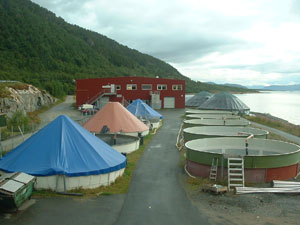 The outdoor department consists of eleven 8 m diameter tanks divided into two rows.
The row of five tanks furthest from the seashore have a volume of 75 m3, while the six tanks closest to the seashore have been extended in height to yield 100 m3 of volume.
There are indivudual tarpaulin covers over the tanks furthest from the seashore, which facilitates photoperiod manipulation.
The outdoor department consists of eleven 8 m diameter tanks divided into two rows.
The row of five tanks furthest from the seashore have a volume of 75 m3, while the six tanks closest to the seashore have been extended in height to yield 100 m3 of volume.
There are indivudual tarpaulin covers over the tanks furthest from the seashore, which facilitates photoperiod manipulation.
The tall tanks closest to the seashore have a water consumption of around 1000 l per tank, and if these were to be used, there would be insufficient water to operate the entire facility. The dimensions of the effluent piping is also not sufficient to drain the required flow-through. For this reason, these tanks are not used.
The 14-meter tanks tanks have a volume of 300 m3 (14 × 2 m). They also have overbuilt tarpaulin tents for photoperiod manipulation, and have similar problems with providing the necessary flow-through due to under-dimensioned effluent piping.
Water intakes
Freshwater intake
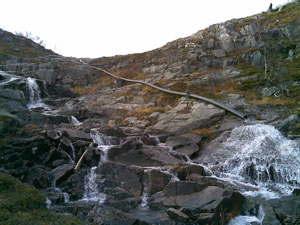 A ditch and weirs redirect the adjacent stream/creek so that it empties into Litjevannet (the sourced lake) and sustains the facilitie's water consumption.
For additional water, a siphoning pipe is installed between the larger lake, Langevannet, to a second lake, Storelvvannet which in turn drains into the aforementioned creek.
The siphoning pipe is Ø250 mm HDPE pipe and extends 800 meters between the lakes.
A ditch and weirs redirect the adjacent stream/creek so that it empties into Litjevannet (the sourced lake) and sustains the facilitie's water consumption.
For additional water, a siphoning pipe is installed between the larger lake, Langevannet, to a second lake, Storelvvannet which in turn drains into the aforementioned creek.
The siphoning pipe is Ø250 mm HDPE pipe and extends 800 meters between the lakes.
The water intake in Litjevatnet is a pipe that extends approximately 100 m into the lake and has a surrounding basket filter at the end. It is suspended by ropes from anchored buoys and can be adjusted to draw water from varying depths in order to ensure the desired water temperature. During spring and summer, surface temperatures can climb higher than what is optimal for the fish.
From the lake down to the facility, the main inlet line is approximately 1000 m long and consists of two buried Ø225 mm pipes. Each pipe has a theoretical capacity of 8 m3/min, however due to pressure losses in bends and reductions, the real sum total is around 9 m3/min. The original site survey calculated a natural supply from the surrounding catchment of 16 m3/min, however these estimates were too high. A drought in the summer of 2008 reduced the total capacity down to 5-6 m3/min.
Apart from the intake basket filter, the facility does not further filtrate or chemically treat the source water.
When the water arrives at the facility, it first comes in to Gjøvik settefisk, and then continues to Rognbanken and the outside areas. The rough estimates of consumption in the different areas is: 1.5 m3/min in Gjøvik settefisk, 2.5 m3/min in Rognbanken, and the remaining volume goes to the outdoor department and 14 meter tanks.
Seawater intake
The seawater intake extends around 100 m into the bay and draws from a depth of 8-10 m depending on the tide. Pumps and a UV filter systen are installed in a container by the seashore, and the capacity is 4.3 m3/min. The facility does not use seawater as culture water, however it is used in the energy recovery/heating systems at Gjøvik settefisk and Rognbanken. It is also used to heat exchange with the inlet water to the outdoor and 14 m tank areas during winter.
Aeration and oxygenation
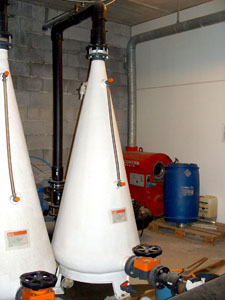 There are separate installations for aerating and oxygenating the water at Gjøvik settefisk the Rognbanken.
The source water is aerated by first passing through a large cascade aerator, and then six smaller column aerators.
After aeration, all the water is supersaturated with oxygen with the exception of water for roe incubation, start-feeding and the first three weeks after start-feeding.
There are separate installations for aerating and oxygenating the water at Gjøvik settefisk the Rognbanken.
The source water is aerated by first passing through a large cascade aerator, and then six smaller column aerators.
After aeration, all the water is supersaturated with oxygen with the exception of water for roe incubation, start-feeding and the first three weeks after start-feeding.
Both Gjøvik settefisk and Rognbanken use oxygen cones to dissolve oxygen under pressure. In the outdoor tanks and the 14 meter tanks, additional oxygenation can be added through fine-pored diffusers directly in the tanks. Supersaturated water from the cones then acts as the base oxygenation source, but topped off by the diffusers in e.g. periods of high growth. Experience has shown that oxygen concentrations in the outlet may be be optimal in the morning, but as the day progresses with a high feeding regime, the oxygen concentration can drop dramatically.
The diffusors also act as emergency oxygenation in case of equipment failure and a cease of water flow. The requirement, should flow cease, is that the diffusers are able to maintain oxygen levels in the 14 meter tanks with 15 metric tons of fish at 14°C.
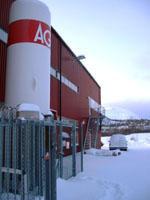 Tank oxygen concentration is controlled by saturation measurement probes in the outlets, and the target outlet saturation should read 90%, though not above 20-21 mg/l in periods with cold temperatures.
Oxygen saturations up to 270% have been employed, however a few centimeters after introduction to the tank the saturation drops below 100%.
The facility has not had problems with gas bubble or other saturation diseases, nor have they had a history of excessive CO2 concentrations.
Tank oxygen concentration is controlled by saturation measurement probes in the outlets, and the target outlet saturation should read 90%, though not above 20-21 mg/l in periods with cold temperatures.
Oxygen saturations up to 270% have been employed, however a few centimeters after introduction to the tank the saturation drops below 100%.
The facility has not had problems with gas bubble or other saturation diseases, nor have they had a history of excessive CO2 concentrations.
The facility purchases liquid oxygen which is stored in a rented pressure tank outside and refilled by tanker truck.
Heating and heat recovery
 Gjøvik settefisk and Rognbanken have separate systems for heating and heat recovery.
Both systems feature wastewater/inlet-water plate heat exchangers (PHE), heat pumps to cover the PHE efficiency gap, and seawater heat exchangers to prime the heat pump cycle.
Gjøvik settefisk and Rognbanken have separate systems for heating and heat recovery.
Both systems feature wastewater/inlet-water plate heat exchangers (PHE), heat pumps to cover the PHE efficiency gap, and seawater heat exchangers to prime the heat pump cycle.
The water capacity of Gjøvik settefisk is 1100 l/min, using a single heat pump with a 37 kW (50 HP) compressor, while at Rognbanken the capacity is 2300 l/min using three 44 kW compressor heat pumps in parallel. In order to prevent film fouling and blockage of the shell-and-tube exchangers (heat pump evaporators and condensers), secondary PHEs are employed in a closed glycol circuit between the heat pumps and the inlet/wastewater circuits.
Heating is not applied to the outside and 14 meter tank areas, with the exception of seawater heat exchange. Inlet water temperatures during the winter can drop as low as 0.6°C and heat exchanging with seawater has been able to bring this up to 1.4 - 1.7°C.
Feeding equipment
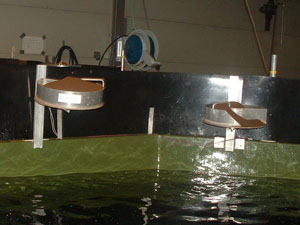 The facility uses various types of automated feeders depending on the size of the fish.
Disc/plate feeders are used for start feeding and the smaller tanks, while in the larger indoor tanks, hoppers with either rotating or long screw spreaders are used.
The facility uses various types of automated feeders depending on the size of the fish.
Disc/plate feeders are used for start feeding and the smaller tanks, while in the larger indoor tanks, hoppers with either rotating or long screw spreaders are used.
For feeding of the outdoor and 14 meter tanks, a somewhat older type of pneumatic central feeding system is used, which is computer controlled.
Transportation and grading
 To grade the fish, the facility uses a conveyor grader with three size grade outlets.
To transport the fish, a vacuum pump was previously used, however this has recently been substituted by a single-vane impeller pump.
The impeller pump is preferred as it provides a continuous delivery of fish.
To grade the fish, the facility uses a conveyor grader with three size grade outlets.
To transport the fish, a vacuum pump was previously used, however this has recently been substituted by a single-vane impeller pump.
The impeller pump is preferred as it provides a continuous delivery of fish.
Fish are graded once the fish size in a tank reach a certain spread. This is usually done a maximum of four times in the production cycle, starting at the earliest when the fish are 3 grams.
At first grading, the the largest grade will be moved outside for to produce 0-yearold or fall smolt. The same is done for the second grading before starting the photoperiod manipulation regime. The remaining fish is retained for wintering to produce 1-yearold smolt.
During grading, counting and weight sampling is done simultaneously in order to update the production control estimates.
Vaccination
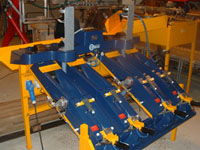 The facility has an automated vaccinator with four channels, however this is only used for the somewhat larger 1-yearolds in April/May.
0-yearolds are injection-vaccinated manually by highly skilled specialists that are hired in for the occasion and spend the late summer and fall travelling from hatchery to hatchery.
The facility has an automated vaccinator with four channels, however this is only used for the somewhat larger 1-yearolds in April/May.
0-yearolds are injection-vaccinated manually by highly skilled specialists that are hired in for the occasion and spend the late summer and fall travelling from hatchery to hatchery.
Control and monitoring
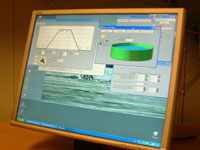 There are sensor probes for monitoring oxygen concentration in all larger tanks and at all main inlet lines, as well as temperature probes on all water sources.
In addition, flow meters are employed for monitoring the total flow entering the facility.
These probes report to hubs that are connected to and displayed on the computers where minimum alarm levels can be set.
There are sensor probes for monitoring oxygen concentration in all larger tanks and at all main inlet lines, as well as temperature probes on all water sources.
In addition, flow meters are employed for monitoring the total flow entering the facility.
These probes report to hubs that are connected to and displayed on the computers where minimum alarm levels can be set.
There are multiple computer monitoring and control systems employed simultaneously:
- The pneumatic feeding system for the outdoor and 14 m tank areas.
- The larger production tanks have a system for regulating oxygen levels by controlling the O2 flow to the diffusers.
- The lights for photoperiod manipulation in the outdoor areas, following a set daily lighting profile.
- The heating and heat recovery systems, controlling both actuated valves/bypasses and heat pump thermostat settings.
- A system for planning, updating and following up of production parameters.
There are also two emergency generators (one in Gjøvik settefisk and one in Rognbanken) that automatically engage in the event of a power outage. These primarily power the heat pumps, the pumps to the oxygenation systems and lights. The facility rarely experiences outages, and only for short periods of time. The emergency generators are still tested every 14 days as a precaution.
Waste handling
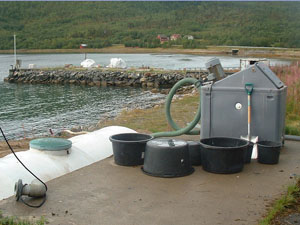 Morts collected at the facility are stored in formic acid and collected by a local company: Akva Ren.
The facility uses a propeller churner to grind up the morts in formic acid before it is pumped to a larger storage tank.
When the storage tank fills, the waste collection company is phoned for pickup.
Other consumable wastes is source separated for collection by the municipal waste service.
Morts collected at the facility are stored in formic acid and collected by a local company: Akva Ren.
The facility uses a propeller churner to grind up the morts in formic acid before it is pumped to a larger storage tank.
When the storage tank fills, the waste collection company is phoned for pickup.
Other consumable wastes is source separated for collection by the municipal waste service.